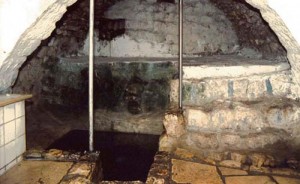THE MIKVAH OF THE HOLY ARI
by Chana Katz
There’s no way to get around it — whether you go to the ARI MIKVEH from the top of the mountain or the bottom there are dozens of stairs to descend one way and at least a hundred to ascend the other. But finally you’ve reached the last step…a plunge back 800 years into the mystical, ritual-immersion pool fed by pure cold waters from the spring directly underneath.
[photo courtesy of www.thirdtemple.com]
FROM NEAR AND FAR
Brrr! A bit chilly, you say.
Yes, but there must be some reason why this mikveh is so popular that an estimated
500,000 visitors — from Tsfat and from all over the world — come to immerse in its spiritually purifying waters every year. And why it is kept open 24 hours a day, seven days a week, holidays and Shabbos included!
Perhaps not the least is that the holy ARI — Rabbi Issac Luria — made the mikveh legendery
during the peak of Tsfat’s “golden era” of kabbalah in the 1500s. Not only did the Ari and his
contemporaries such as Shulchan Aruch codifer Yosef Caro use the mikveh regularly, but a
famous story tells how the Ari used it even after his passing!
LIVING WATERS
Dovid, the current caretaker of the mikveh, which borders on Tsfat’s “Old Cemetery”, related this story:
“Before the Ari died he instructed his students that upon his passing they were to bring his body to the mikveh and he would do the final purification himself.
“After the Ari died, his students followed his instructions and brought him to the mikveh and placed him in it standing with the water up to his head.
“Then his closest student, Rabbi Chaim Vital told the Ari: ‘All you asked for we did. And now you do what you said.’
With that, the Ari lowered his head into the waters to complete the entire immersion of his body into the water. And then his students continued on with the burial just meters from the mikveh site.
“That story was written down by Vital himself and that is why they call the mikveh after the Ari,” concluded Dovid.
GUARANTEED T’SHUVAH
For the local Tsfat residents who use the mikveh daily, usually in preparation for prayer, it may be because the mikveh offers the highest level of purity, since it draws its waters from the flowing, fresh underground source. Although women cannot use the mikveh because men frequent it at all times of day and night, the Ari mikveh also meets the higher standards required for a women’s mikveh.
But its mystical implications are as spiritually refreshing as the chilly spring water itself. It is said that anyone immersing in the Ari’s mikveh is guaranteed to do “t’shuvah” – to return to the way of G-d and Torah — before he dies.
NOT A SINGLE FAUCET
Unlike many of today’s modern mikvehs which have all the timely conveniences such as heating and
fancy marble floors, the Ari’s mikveh doesn’t have a single faucet. The water flows directly into the 1.30 meter-deep pool from the underground spring. An exit hole at the opposite side of the pool allows the water to continue on its underground passage.
Modernity has given way to the outer chambers of the Ari mikveh, where bathrooms, changing rooms and carved cubby holes in the stone wall providing places to store the clothing have been added over recent years. But the mikveh itself is intact in its original cavernous setting, adding to the bather an inexplicably delicious feeling of antiquity and spirituality.
Chana Katz, a former South FLorida journalist, lives in Tsfat. Her articles on life in Israel have reached publications throughout the world.

